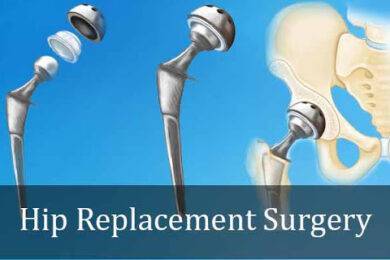A Hip replacement surgery is performed to replace damaged or diseased hip joint by an artificial joint implant. Generally, adults or people having conditions of arthritis experience excruciating hip pain and inflammation that led them to take a surgical technique to have long term relief. An external injury or sudden hip fracture can be the typical reason behind the immediate hip replacement surgeries.
The surgical procedure helps millions of people regain stable mobility and perform daily life activities without much trouble. However, hip replacement surgery requires a span of a few months for recovery.
How to prepare for Hip Replacement Surgery?
The orthopedic surgeon and its team will examine the body and ask a few relevant questions regarding your health conditions that reflect the line of surgery;
- The team will inquire about medical history, chronic ailments, allergies, current medications, etc.
- Calls for rounds of X-rays. In complex cases, MRI might be needed.
- Examine the range of motion of the hip joint and the strength of the surrounding muscles.
In what conditions Hip Replacement Surgery is required?
Mostly the hip replacement surgery is suggested to elders whose hip joints weaken and prone to gets injured, in other cases, it is necessary due to certain medical conditions;
- Osteoarthritis – A condition that is popular as ‘wear and tear arthritis’ that increases the risk of damaging the slick cartilage that is meant to cover the end or caps of bones affecting the movement of joints.
- Rheumatoid Arthritis– It’s a gradual state of inflammation that can erode cartilage or underlying bone caused by an overactive immune system. With age, arthritis will affect bone shape resulting in damaging and deforming joints, causing extreme pain and swelling.
- Osteonecrosis– It’s a condition where the call portion of the hip joint will not be able to get enough blood supply resulting in fracture or dislocation of bone. Due to weakness, the joint may collapse or deform after some time.
What are the different types of hip replacement surgery?
Today, the advancement in medical practices has brought three major kinds of hip replacement surgeries that include;
- Total Hip Replacement
Total Hip replacement is the most preached surgery in which damaged joints or sections of hips are removed and replaced with artificial implants. The patient’s Hip socket is replaced with a reliable metal or plastic cup, and the femoral head will be replaced with a ceramic/ metal ball. The new ball is then attached to a metal stem inserted into the top of the femur and fixed with screws that prevent dislocation.
To perform Total hip replacement, the ortho surgeon will choose two major surgical approaches; the posterior approach and the anterior approach.
During the operation, the surgeon will prefer to make incisions on either the posterior (back) or (anterior) front side of the hip. Both approaches are adaptable and offer relief in pain, supporting regular movements, including walking, balancing body weight within weeks of surgery.
- Partial Hip Replacement
In a partial hip replacement, the surgeon will apply the same technique to replace one side of the joint (femoral head) instead of both sides. The partial replacement is done on the conditions of the fractured hip due to older age, external injury, unforeseen issues, etc.
- Hip Resurfacing
Hip resurfacing is mostly opted for younger patients to give a more active lifestyle for the future. In this procedure, the femoral head is smoothly moved by the surgeon inside the round socket of the hip bone. After resurfacing, the socket will be lined with cartilage that assists in the movement of bones.
Risks and Complications
Not all people face complications after the surgery; these conditions are seen to the least number of patients. However, some common risk factors that have witnessed are;
- Loosening of the new implant
- Dislocation
- Infection
- Excessive bleeding
- Clotting
- Excessive Bone growth.
Post-Surgery Precautions At Home
There are a list of instructions and precautions planned by your surgeon according to the health conditions. After Hip replacement surgery, it is mandatory to follow some measures to ensure safety and easiness in routine activities;
- Resist to climbing stairs in the initial level;
- Make new arrangements in the bathroom, around gates, that helps in walking.
- Remove any obstacles like carpets, underlying wires around the walking places.
- Sit at the right posture, firm, arrange for high-inclined chairs.
- Use an elevated toilet seat that prevents bending of hips.
- Take supplements and pain medications as prescribed by doctors.
Results
After hip replacement surgery, you will feel less pain and increased range of motion in later times. But the patient cannot expect to do everything right after the surgery, for a full recovery it will take 6 to 8 months precisely taking all precautions.











